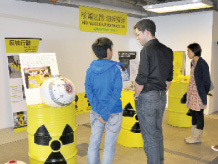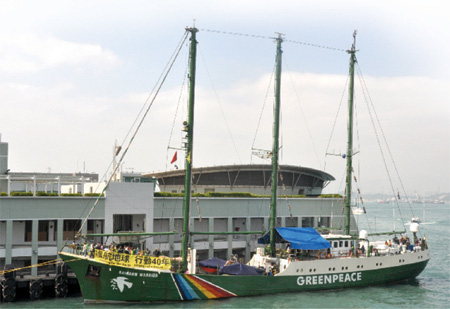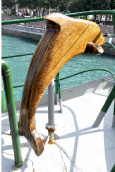Rainbow Warrior
Updated: 2011-03-15 07:07
By Kane Wu(HK Edition)
|
|||||||||
|
Greenpeace Hong Kong office sets up banners, posters and installations to call for "no-nuclear" movement in the city. Kane Wu / China Daily |
|
Moored at No 2 Central Pier in Hong Kong, Rainbow Warrior receives more than 1,000 visitors a day. Kane Wu / China Daily |
Forty years ago a chartered fishing boat sailed from Vancouver to protest US nuclear testing off the Aleutian Island. The protest vessel had been renamed Rainbow Warrior. With that voyage began the campaign that has taken the Greenpeace message of protecting the environment around the world. In February, one of the heirs to the original Greenpeace mission visited Hong Kong. Kane Wu reports.
It was Valentines Day, Feb 14, and the crowd drawn to Victoria Harbour's "A Symphony of Lights" was large than the usual 8pm crowd that gathers along the Tsim Sha Tsui waterfront.
An uninvited was there for the renowned light and sound show - standing outside the spectrum of the nightly program's regular visitors. It wasn't there to celebrate Valentine's Day. Actually it was there to protest about the wasted energy as buildings around the harbor become bathed in colorful display lights every night of the week. .
A grand projection on the wall of the Hong Kong Culture Centre read "Forget Nuclear, Love Energy Efficiency". Twenty meters from the projected letters the vessel Rainbow Warrior rode on the waters. Rainbow Warrior is the flagship of the international environmental NGO, Greenpeace.
Rainbow Warrior, on a farewell tour of Asia, was here to protest the government's latest proposal to increase the portion of electricity generated by nuclear power and to share her long legacy with the people of Hong Kong.
"We don't need to put out a show like this every night. There are not so many tourists to attract. The government should consider how to save energy alongside economic development," Prentice Koo, campaigner from Greenpeace Hong Kong, tells China Daily. "But we hope the government will save energy by limiting electricity usage, instead of resorting to nuclear power."
And nothing can convey the message better than Rainbow Warrior, a ship that has actively supported Greenpeace campaigns against seal hunting, whaling and nuclear weapons testing.
|
Rainbow Warrior's mascot - Dave the dolphin. Kane Wu / China Daily |
Fifteen crew members from different countries sail across the latitudes to join campaigners from Greenpeace bases around the globe, raising awareness of environmental issues. They have chased fishermen, petitioned for the end of nuclear proliferation and organized protests against policies harmful to the environment.
They are always en route somewhere and have gone through adventures harder than most people can imagine. Every crew member has stories to tell.
"We had some situations with French fishermen and also in the Amazon in Brazil. When we were crossing the Indian Ocean, some pirates even wanted to come on board our ship," Daniel Rizzotti, Rainbow Warrior's current captain-on-duty, tells China Daily. The 44-year-old sailor spent 20 years at sea and has been the captain of all the Greenpeace ships since he joined the NGO in 2000. "But the worst (trip) was with Japanese whalers in Antarctica."
That was the anti-whaling mission in 2008 when the sea shepherd spent almost three months in Antarctic international waters, locating a Japanese whaling ship before finally kicking her out of the area.
Navigating in the cold polar winds looking for a ship that could be anywhere in the boundless Southern Ocean was not easy. The 40-meter-long two-engine ship was going about aimlessly. A helicopter tried to assist in expanding the range of the search. There was nothing in sight but the fog and sea birds, until, at last, the factory processing ship of the Japanese whaling fleet, Nisshin Maru, emerged above the horizon.
Then the arduous chase began. "We chased after them all the time. Wherever they went we just followed, until they were out of the fishing area," says Chief Mate Pep Barbal Badia. The 45-yaer-old Spaniard started working for Greenpeace in 2003 and has been involved in most of its campaigns over the years.
"Fishermen are not nice. They are the most dangerous people," he says. In the Southern Ocean waters, Rainbow Warrior and Nisshin Maru, at a point, came so close that they could almost bumped one another. When another Japanese ship arrived to refuel Nisshin Maru, the sailors rode an inflatable boat, going in between the ships to stop the refueling.
"There were only us and the Japanese boats. If anything happened, nobody would come to our rescue," Badia says. Fortunately the Japanese boats couldn't linger long before they ran out of fuel. Mission completed.
There were times when confrontation with the fishermen got violent. Badia recalls a trip to stop dolphin killers in the English Channel in 2005. "We were trying to stop them when they were pulling out the net, by all kinds of means," he says. Fully geared English fishermen attacked Greenpeace's action team and threatened to do greater damage to the boat.
The situation didn't get worse because all the crew members and campaigners stood by Greenpeace's rule of non-violent direct action. And a doctor on the ship was able to dress most of the minor wounds the members suffered.
"They trained us how to react to violence. We are not pushing them to protect the environment. When other people attack us, we try to calm down and be as nice as we can," Rizzotti says.
Even so, Rainbow Warrior's missions still have evoked violent reaction. On July 10, 1985, the first Rainbow Warrior was anchored in port at Auckland New Zealand, while on a mission to protest French nuclear testing in the South Pacific. It was to be the most disastrous moment for Greenpeace and Rainbow Warrior. Two explosions ripped the hull of the vessel. Rainbow Warrior sank within four minutes. It didn't take long for New Zealand authorities to capture the culprits and discover that the perpetrators not only were members of the French intelligence service (Direction Gnrale de la Scurit Extrieure, or DGSE) but that the instigator and perpetrator of terrorism and murder was the government of France. The French would not see justice done and when the perpetrators of the sabotage were sentenced to 10 years in jail, France threatened to destroy New Zealand's economy by blocking her exports to the European Community unless the French government agents were set free.
In 1987, under international pressure, the French government paid $8.16 million to Greenpeace. Rainbow Warrior was refloated and scuttled in Matauri Bay, near the Cavalli Islands, on Dec 2, 1987, to serve as a dive wreck and fish sanctuary.
A second ship named Rainbow Warrior was acquired in 1989. She has carried on the heroic spirit of her predecessor ever since. People around the world made films and wrote books to pay tribute to the ship that became a symbol in the fight against assaults on our planetary environment. U2, one of the most successful rock bands in the West, wrote a song about her titled "Pride" in 1988. In only five months, Rainbow Warrior will retire.
"Basically the ship is going to be converted into a hospital in Bangladesh. Another NGO is going to take care of the ship. The name and the flag will be changed," says Rizzotti.
Hong Kong was the ship's first stop on her farewell tour around Asia. Apart from participation in the "Symphony of Light", Rainbow Warrior also sailed to China Light & Power's Castle Peak Power Station to protest the electricity company's tariff structure that encourages large commercial clients to waste electricity and to be subsidized for their excise by home users. Still compared with other places, the crew members feels anything but hostility in the city.
"People here are well-educated, so they are more receptive to our campaigns. It's easy to send our messages to the public. We don't need to be too strong," Rizzotti says.
Rizzotti was on the ship's first visit to Hong Kong back in 2005, during a campaign for clean energy. He feels attitudes have changed over the years. "They are more open and they criticize more. They are also willing to participate and feel more confident to express themselves," he says. "The government and the people in power are also more willing to listen." The only thing difficult though, he adds, is that "they don't necessarily change their mind".
More than 5,000 people went on board Rainbow Warrior during her last stay in Hong Kong. A lot of them have actually heard about it for the first time. They listened to the vivid stories from the sailors and messages from the local campaigners.
"The value of the ship is that we can point out the problem to the public in a more direct way and act right where the problem occurs," Koo says. "Hong Kong people are pragmatic. They want to hear about the solutions we have to offer to the environmental problems."
Having left Hong Kong at the end of February, the ship is in South Korea protesting over-fishing and sea contamination. In November, a brand new Rainbow Warrior 3 will take her place and continue the voyage.
"We are committed to environment and the dreams of people. We are committed to working for a good future," says Rizzotti, who is very likely to stay on the new ship as captain. "Sometimes we can change things. Sometimes we can't do so much. But you can at least give people a chance for something better."
"I would like to encourage more volunteers from Hong Kong to come on the trip," he says.
(HK Edition 03/15/2011 page4)


